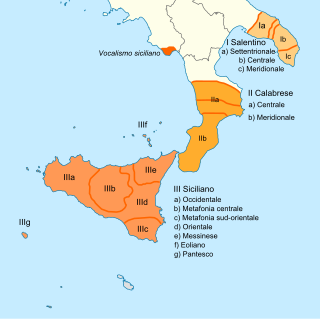Extreme Southern Italian
| Extreme Southern Italian | |
|---|---|
| dialetti italiani meridionali estremi | |
| Native to | Italy |
| Region | Apulia (Salento) Calabria Sicily Campania (Cilento) |
| Ethnicity | Italians, Sicilians |
Native speakers | 4.7 million (2002) |
Indo-European
| |
| Language codes | |
| ISO 639-3 | – |
 Extreme Southern Italian dialects | |
The Extreme Southern Italian[1][2][3] dialects are a set of languages spoken in Salento, Calabria, Sicily and southern Cilento with common phonetic and syntactic characteristics such as to constitute a single group. These languages derive, without exception, from Vulgar Latin but not from Tuscan; therefore it follows that the name "Italian" is a purely geographical reference.
Today, Extreme Southern Italian dialects are still spoken daily, although their use is limited to informal contexts and is mostly oral. There are examples of full literary uses with contests (mostly poetry) and theatrical performances.
Background
The territory where the Extreme Southern dialects are found roughly traces the Byzantine territory in 9th century Italy. In this territory the spoken language was Greek, which still survives in some areas of Calabria and Salento and is known as Italiot Greek (see Greek linguistic minority of Italy).[4]
Varieties
- Sicilian, spoken on the island of Sicily: Western Sicilian; Central Metafonetica; Southeast Metafonetica; Ennese; Eastern Nonmetafonetica; Messinese.
- Sicilian dialects on other islands: Isole Eolie, on the Aeolian Islands; Pantesco, on the island of Pantelleria.
- Calabro,[5] or Central-Southern Calabrian:[5] dialects are spoken in the central and southern areas of the region of Calabria.
- Salentino, spoken in the Salento region of southern Apulia.
- Southern Cilentan: spoken in Roccagloriosa and Rofrano in southern tip of Cilento, which is southern Province of Salerno, in the Campania region.
Phonological features
The main characteristics that the extreme southern dialects have in common, differentiating them from the rest of the southern area dialects are[6]
- Sicilian vowel system, a characteristic not present, however, in many dialects of central-northern Calabria;
- presence of three well perceptible final vowels in most dialects of this area: -i, -u, -a; in Cosentino and in central-southern Salento, however, the final -e is also preserved;
- cacuminal or retroflex pronunciation of -DD- deriving from -LL-. This phenomenon is also found in part of Campania and Basilicata;
- maintenance of voiceless occlusive consonants after the nasals: the word for "eats" will therefore be pronounced mancia and not mangia. However, this phenomenon is absent in Cosentino;
- absence of apocopated infinitives spread from the Upper Mezzogiornoto Tuscany (therefore one has cantare or cantari and not cantà). Also in this respect the Cosentino dialect is an exception;
- use of the preterite with endings similar to the Italian remote past and the non-distinction between past perfect and past past; however, this phenomenon is absent in central-northern Calabria (north of the Lamezia Terme-Sersale-Crotone line).
See also
Bibliography
- Francesco Avolio, Lingue e dialetti d'Italia, 2012, Carocci editore, Roma, ed=2, ISBN 978-88-430-5203-5.
- Giuseppe Antonio Martino - Ettore Alvaro, Dizionario dei dialetti della Calabria meridionale, Qualecultura, Vibo Valentia 2010. ISBN 978-88-95270-21-0.
- Gerhard Rohlfs, ISBN 88-8063-076-8(6th reedition, 2001)
- Gerhard Rohlfs, Dizionario dialettale delle tre Calabrie. Milano-Halle, 1932-1939.
- Gerhard Rohlfs, Vocabolario supplementare dei dialetti delle Tre Calabrie (che comprende il dialetto greco-calabro di Bova) con repertorio toponomastico. Verl. d. Bayer. Akad. d. Wiss., München, 2 volumi, 1966-1967
- Gerhard Rohlfs, Vocabolario dei dialetti Terra d'Otranto). Verl. d. Bayer. Akad. d. Wiss., München, 2 volumi (1956-1957) e 1 suppl. (1961)
- Gerhard Rohlfs, Supplemento ai vocabolari siciliani. Verlag der Bayer, München, Akad. d. Wiss., 1977
- Gerhard Rohlfs, Historische Sprachschichten im modernen Sizilien. Verlag der Bayer, München, Akad. d. Wiss., 1975
- Gerhard Rohlfs, Studi linguistici sulla Lucania e sul Cilento. Congedo Editore, Galatina, 1988 (translation by Elda Morlicchio, Atti e memorie N. 3, Università degli Studi della Basilicata).
- Gerhard Rohlfs, Mundarten und Griechentum des Cilento, in Zeitschrift für Romanische Philologie, 57, 1937, pp. 421– 461
References
- ^ According to the classification of Giovan Battista Pellegrini, see [1] Archived 26 August 2007 at the Wayback Machine
- ISBN 978-88-430-5203-5, page 54.
- ^ "Introduzione ai dialetti italiani meridionali estremi (Alessandro De Angelis)" (PDF). Retrieved January 17, 2013.
- ^ Story of the Sicilian dialect from the point of view of the linguistics, IRSAP Agrigentum
- ^ a b Calabrian in Italian: Calabrese (pl. Calebresi). Synonyms: Calabro, Calabra, Calabri, calabre (m., f., m.pl., f.pl.). Sicilian: calabbrìsi, calavrìsi.
- ^ Giovanni Alessio (1964), I dialetti della Calabria, pp. 27–34
